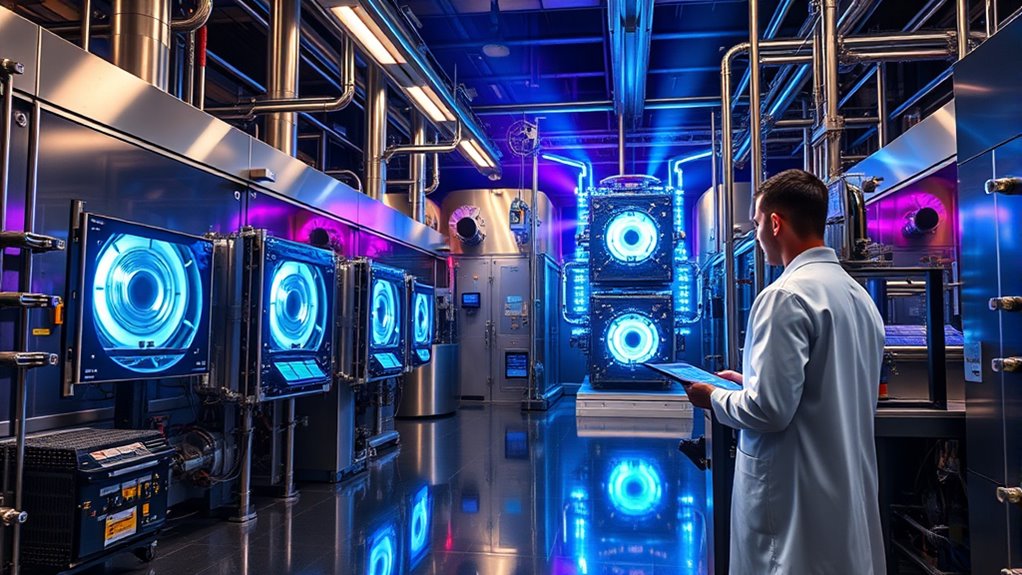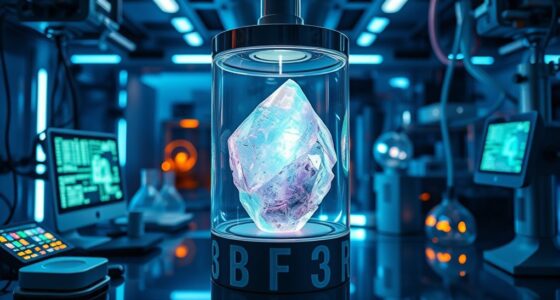A U.S. lab has achieved a major breakthrough by producing more energy from nuclear fusion than the energy put in, marking a pivotal step toward practical clean energy. This milestone demonstrates advances in magnetic confinement, sustaining hot plasma, and overcoming previous technical hurdles. Fusion offers a nearly limitless, environmentally friendly energy source with minimal waste. If you want to understand how this breakthrough could transform energy production, there’s more to explore below.
Key Takeaways
- The U.S. lab has achieved a net energy gain in nuclear fusion, producing more energy than input for the second time.
- This milestone demonstrates significant progress toward practical and sustainable fusion energy on Earth.
- Advanced magnetic confinement techniques enabled the high-temperature plasma necessary for fusion reactions.
- The breakthrough validates years of research and brings fusion energy closer to commercial viability.
- Fusion’s minimal waste and environmental benefits highlight its potential as a clean, limitless energy source.

A U.S. laboratory has achieved a groundbreaking milestone by generating more energy from nuclear fusion than it consumes, marking a substantial step toward harnessing fusion as a practical energy source. This milestone is a major breakthrough in fusion technology, demonstrating that a fusion reactor can produce net energy gain, a critical hurdle in turning fusion into a viable power source. For years, scientists have worked tirelessly, refining designs and experimenting with plasma confinement methods, but recent advances have finally made this achievement possible. When you hear about fusion being called an energy breakthrough, this is precisely what it means: a fusion reactor now produces more energy output than input, indicating that fusion could one day provide abundant, clean power.
The key to this success lies in the innovative design of the fusion reactor used in the experiment. Unlike traditional reactors, this one employs advanced magnetic confinement techniques to sustain extremely hot plasma where fusion occurs. By maintaining the plasma at high temperatures and pressures, the reactor facilitates the fusion of light nuclei—primarily isotopes of hydrogen—releasing enormous amounts of energy. This process mimics how the sun generates power, but capturing and controlling it on Earth has proven immensely challenging. Achieving net energy gain proves that these challenges can be overcome, bringing fusion closer to commercial viability. This achievement also underscores the importance of high-temperature plasma in enabling fusion reactions to reach the necessary energy thresholds. Additionally, this milestone highlights the importance of plasma confinement methods for sustaining the conditions needed for fusion.
Innovative magnetic confinement sustains hot plasma, enabling fusion of hydrogen isotopes and bringing us closer to practical, clean energy.
This energy breakthrough also highlights the potential impact of fusion technology on the future energy landscape. Unlike fossil fuels, fusion produces minimal waste and emits no greenhouse gases, making it an environmentally friendly option. As you consider the importance of sustainable energy sources, this achievement signals that clean, limitless energy might not just be a distant dream. The success in this experiment encourages further investment and research into fusion power, promising a future where energy shortages and climate concerns are substantially alleviated. Moreover, ongoing research into safe fusion reactor designs aims to address remaining technical challenges and improve efficiency, further accelerating progress toward commercial deployment.
While it’s still early days, the progress made in this recent milestone fuels optimism. The experiment demonstrates that fusion reactors can operate efficiently enough to produce excess energy, a feat that many believed was decades away. This breakthrough not only validates years of scientific effort but also accelerates the timeline for potential commercial fusion power plants. As you follow developments in this field, remember that each step forward, like this one, moves us closer to a sustainable, energy-rich future driven by fusion technology. The journey toward practical fusion energy is still ongoing, but this milestone definitively proves that it’s within reach.
Frequently Asked Questions
How Long Will It Take for Fusion Energy to Become Commercially Viable?
You’re probably wondering how long until fusion energy becomes commercially viable. While recent breakthroughs boost hope, fusion commercialization still faces significant technical and economic hurdles. It could take 10 to 30 years before fusion plants are widespread, depending on energy policy support and funding. Governments and private sectors need to prioritize fusion research, shaping policies that accelerate development and deployment, making this clean energy source a reality sooner rather than later.
What Are the Environmental Impacts of Nuclear Fusion?
You might wonder about the environmental impacts of nuclear fusion. Unlike traditional nuclear energy, fusion produces minimal radioactive waste and doesn’t require resource extraction from the earth’s crust. This means fewer concerns about radioactive waste disposal and less environmental disruption. Fusion’s cleaner process could considerably reduce pollution and habitat destruction, making it a more sustainable energy source. Overall, fusion offers a promising, environmentally friendly alternative to current energy technologies.
How Does Fusion Compare to Renewable Energy Sources?
Did you know fusion could provide nearly limitless energy with minimal environmental impact? Compared to renewable energy sources, fusion offers higher energy density and consistent power, making it easier to integrate into existing grids. Fusion safety is a key advantage, as it produces no long-lived radioactive waste. While renewables depend on weather, fusion promises reliable, steady output, complementing renewable integration and helping reduce reliance on fossil fuels.
What Are the Main Technical Challenges Remaining?
You face key challenges in making fusion practical. Plasma stability remains a major hurdle, as maintaining a consistent, controlled plasma is difficult. Neutron shielding is also critical to protect equipment from high-energy neutron damage. Overcoming these issues requires advances in magnetic confinement and materials. Until you address plasma instabilities and develop effective neutron shielding, achieving sustained, commercial fusion energy will stay out of reach.
Will Fusion Energy Be Accessible Worldwide or Limited to Certain Countries?
Imagine a future where fusion energy transforms the world overnight—seemingly limitless and clean. While fusion accessibility will initially be limited to pioneering countries, technological advances and international collaboration could accelerate global deployment. You might soon see fusion power stations popping up worldwide, making energy more affordable and sustainable than ever. The dream of universal fusion access isn’t just science fiction; it’s a potential reality waiting to unfold, transforming lives everywhere.
Conclusion
You can’t ignore how impressive it is that this U.S. lab achieved a net energy gain in nuclear fusion again. It’s like capturing a glimpse of the future of clean energy, with a recent breakthrough showing they produced 20% more energy than they consumed. This milestone proves fusion could become a viable power source sooner than you might think. As research advances, you might see a world where limitless, sustainable energy is within reach, transforming how we power our lives.









